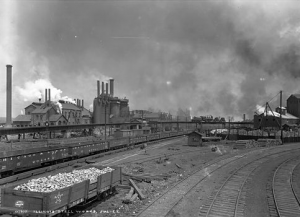The beginning of a large iron and steel industry in the Chicago region during the nineteenth century was a function of entrepreneurial effort and a geographical advantage. Mills could obtain raw materials from the vast iron ore deposits in the Lake Superior region relatively cheaply and easily. Because most of the iron ore used by the American ste el industry during its rise was mined in Minnesota and Michigan mills located along the Great Lakes were well positioned to enjoy lower costs than their competitors elsewhere, especially after the late 1800’s, when U.S. government regulators ended the “Pittsburgh Plus” pricing system that had protected Pennsylvania mills from competition. Up until that time Pennsylvania and Pittsburgh had a strangle hold on the iron ore / steel business.
el industry during its rise was mined in Minnesota and Michigan mills located along the Great Lakes were well positioned to enjoy lower costs than their competitors elsewhere, especially after the late 1800’s, when U.S. government regulators ended the “Pittsburgh Plus” pricing system that had protected Pennsylvania mills from competition. Up until that time Pennsylvania and Pittsburgh had a strangle hold on the iron ore / steel business.
The success of iron beds throughout the Pittsburgh area was a result of small independently owned foundries having direct, daily, access to the raw materials they needed to produce their beds. Foundries as far away as Chicago had to have materials brought in, until such time that their own steel production surpassed that of the Pittsburgh foundries.
Once the Chicago based steel mills started producing all the iron ore and steel west of the Mississippi, the production of iron beds was no longer centered in the Pittsburgh area and the prices to have them transported from that area to the Midwest were no longer necessary. The Chicago foundries enjoyed more success with everything from iron beds to cast iron stoves an particularly the iron rails that took the trains west and helped open up and populate the great western states.Chicago-area mills sold large quantities of iron and steel products to the railroads and companies that built skyscrapers and bridges, as well as to those that made goods such as pipe, containers, and wire. Dozens of area companies, from giants such as Pullman and Crane to much smaller firms, generated considerable local demand for steel. As local and national demand rose, mergers were thinning the numbers of steel producers. One of the first great mergers occurred in 1889, when most of the large Chicago-area mills—including North Chicago, South Works, Union, and Joliet—combined to form a huge new entity, the Illinois Steel Company. The world’s largest steel company, Illinois Steel not only owned multiple mills employing a total of about 10,000 men but also controlled iron mines, coal mines, and transportation systems. By the end of the nineteenth century, workers at the various Chicago-area mills owned by this company were turning out about a million tons of finished steel per year.
In the early twentieth century, even after many of Chicago’s largest mills were absorbed into a giant national corporation, the area’s importance within the American steel industry continued to rise. The most important single development in the history of the industry occurred in 1901, when New York banker J. P. Morgan engineered the creation of U.S. Steel, the world’s largest business enterprise. Illinois Steel (by then also known as Federal Steel, a holding company created by Chicago lawyer Elbert H. Gary in 1898) became part of this giant entity. U.S. Steel closed some of the Chicago-area mills, but the South Works—which employed about 11,000 people in 1910—stood as one of its largest plants.
Since before the Civil War, iron and steel mills have ranked among the largest economic enterprises in the Chicago area. A by product of that has been some of the best antique iron beds to have been produced throughout the Victorian era of the 1800’s. Chicago became the standard for iron ore and steel production in the 1800’s and beautiful iron beds were the beneficiary .
I hope you’ve found this blog informative . I invite you to revisit my website
to answer any and all questions you might have about antique iron beds.
I also invite you to take a look at our company Face Book page for multiple photo albums on Custom Finishes, Canopy Conversions and a comprehensive “Before & After” King Conversions album.







